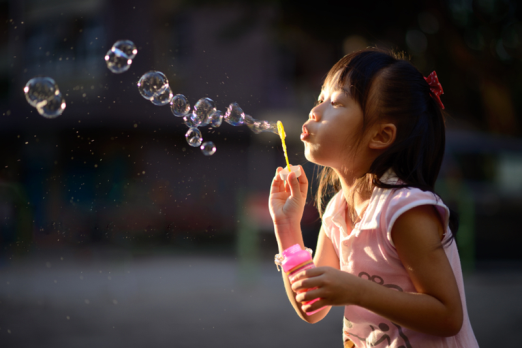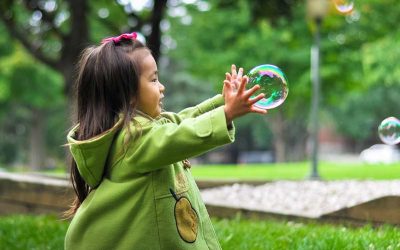Bubbles are a great activity used by ALL therapists, occupational therapists and speech therapists alike. Here are 8 skills that can be improved with bubble play. We tend to always have them in our therapy toolbox. Bubbles are inexpensive, portable, AND encourage interaction. And most importantly they are fun and kids LOVE them!
1. Bubbles help to promote good use of eye contact.
When engaging with your child in bubble play, watch for their anticipation of wanting more bubbles. Wait for eye contact before you blow more bubbles. If they do not look to you right away, blow the bubbles again, bring the jar to your eye level call their name ask, “bubbles?” and wait for eye contact.
2. Bubbles help to normalize sensory processing skills.
Bubbles and wet, sticky, and slimy. And the physical act of blowing can be a very effective sensory-based way to help children “organize”, calm, and focus their bodies.

3. Watching bubbles can help improve visual tracking skills.
Where did the bubbles go? Some are fast and some are slow. Some go up and some go low! Once your child is engaged, point out the bubbles and try and have your child look at them to their, left, right, up high and down low.
4. Use bubbles to teach specific early speech sounds.
Bubble play is great for teaching early speech sounds called “bilabials” which are /p/, /b/, and /m/. When you blow the bubbles, you can model “buh” /b/ for bubbles and “buh” for blow. Practice “puh” /p/ when popping bubbles, and “muh” /m/ for “more” when it’s time for them to request for more bubbles.
5. Blowing bubbles helps to develop hand eye coordination.
The entire process of “bubble play” takes serious practice to link up what the eyes and hands are doing in order to accurately dip and blow with a wand. It can get messy, but go outside and let your little one work on this coordination!

6. Use bubbles to encourage your child to request.
Start blowing bubbles. Once your child is engaged, close the bubble jar and hold it up at eye level. Wait for your child to request more in their own way. Depending on your child’s stage of development this could be by looking at you and smiling, reaching for the container, or by using signs, words, or phrases.
7. Bubbles can be used to improve oral motor skills such as lip rounding.
When you blow bubbles through the wand, your lips round to make a little circle. I call it “fish lips”. Watch your child as they blow bubbles to see if they are rounding their lips. If their lips are more on the flat side instead of round, gently squeeze their cheeks forward to get their lips to pucker and form the right position.
8. Playing with bubbles works on coordination of fine motor skills.
During bubble play, kids have the opportunity to practice pinching the skinny wand, coordinating two hands to hold the bottle and dip, holding the blower with a pencil-like grasp, opening and closing the bottle, and using hands in different ways to pop the bubbles (poke them with their index finger, “squeeze” them to grab bubbles with the whole hand, or they can use two hands together to clap the bubbles).

As you can see, bubbles are a great way to engage with your child and target speech, language, and motor development at the same time! You are your child’s most important “therapist” so watch our video on U-Tube for models on how to target therapy goals through bubble play and have FUN!


One thought on “Bubble Play and Speech & Motor Development”